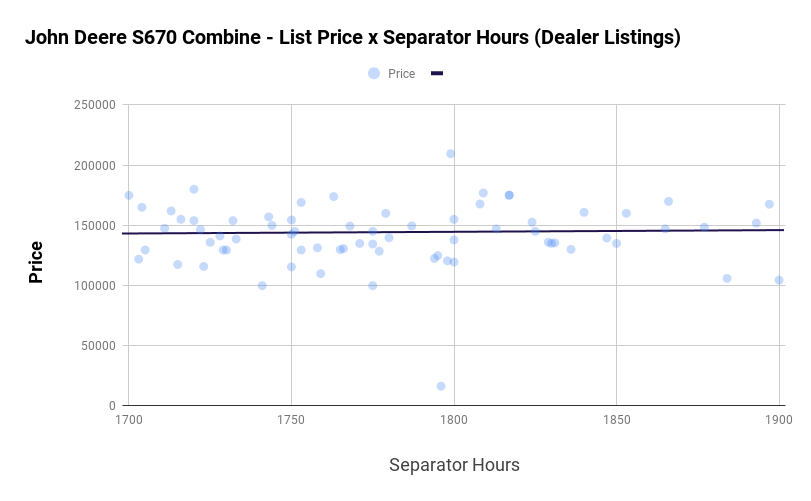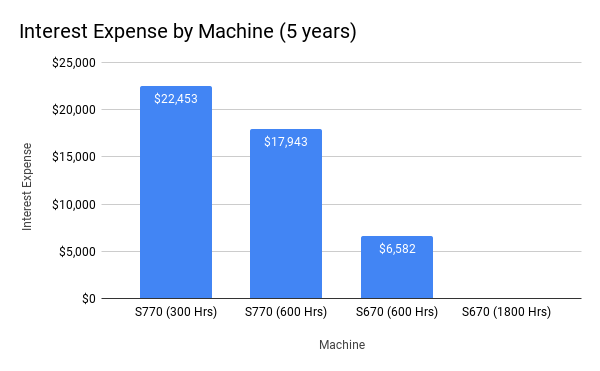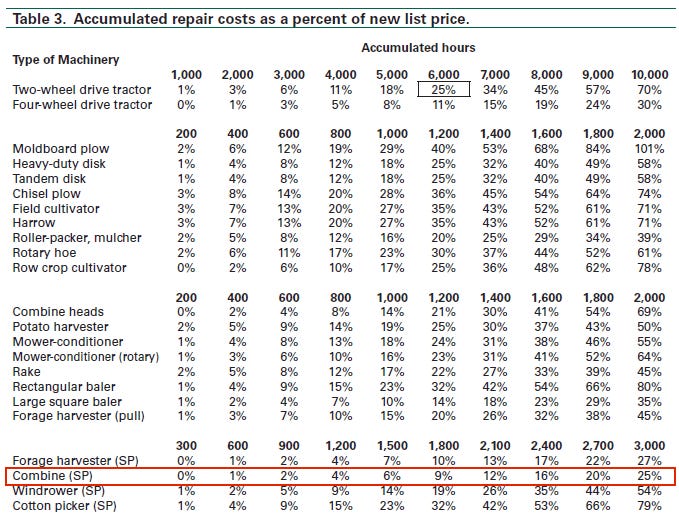
2021 has been a pretty good year for corn and soybean prices, and many farmers are looking to upgrade equipment. One of the highest value items on that list is the combine. But, at the end of the day, does it really make sense, or is it a high-dollar mistake waiting to happen?
John is one of our buddies, and like everybody else, he’s trying to figure out what to do. Is it a better idea to pick up a bigger, newer combine with lower hours, trade in for another one like he’s already got but with lower hours, hang on to what he’s got, or something different altogether?
So, over beers one night, we started talking through his options, and penciled some things out. If you’re in a similar position, maybe this will be helpful to you.
Here are a few key factors to consider when deciding what to do.
- Usage
- Current Market Value
- Interest Expense
- Expected Repairs
- Fuel Expense
- Actual Depreciation
He’s currently using a John Deere S670 with ~1800 separator hours. He’s farming about 1,800 acres with a 50/50 corn and soybean rotation.
Usage
One key factor to consider is how long you plan on owning your next combine. How many years is this thing going to live in your machine shed, and how many separator hours are you going to put on it per year? In John’s case, it’ll probably be about 5 years and ~215 separator hours per year.
Current Market Value
One of the biggest pain points for farmers is understanding the current value of their farm equipment. We looked at prices for over 825 John Deere S670s currently listed on MachineFinder.com and narrowed down the results to just those machines between 1700-1900 hours. This resulted in an average dealer list price of ~$142,000 for 72 machines.
For the sake of this argument, let’s assume trade in value of roughly 80% of list value for our John Deere S670. That puts the trade-in value of John’s combine at about $113,600.
Using the same basic data noted above to compare the following, let’s assume a purchase price of ~93% of List Price for each. Here’s the options he’s looking at.
-
- Trade up to a John Deere S770 with 500-1000 hrs?
- Trade up to one with less than 500 hours?
- Or, trade in for another S670 with lower hours?
- Or, keep the S670 we have now, knowing we’ll have high repair costs in the future?
John plans on applying the trade-in value of of his S670 to the purchase price of the combines listed above, resulting in our “Trade in Boot Value.” Let’s also assume that the “Trade in Boot” is going to be fully financed and that our current S670 is paid off.

Interest Expense
For each combine above we will assume a payoff term of 5 years with an interest rate of 3.5%. As expected, the S770 with the lowest hours represents the highest interest expense as it has the highest purchase price.
Expected Repairs
Repairs are likely the hardest part of the equation – as it’s nearly impossible to predict. However, let’s agree that as the machine gets older and hours are added – the expected repair costs go up at an increasing rate.
To establish some kind of baseline, we used Iowa State University’s numbers for repair costs (AgDM A3-29). Your repair costs may vary.
For each combine we can figure the percent (%) from the table above by using the list price for each. Newer combines have a higher list price, and the argument is that parts will inevitably be more expensive, even if everything else is equal.
If we slot in John’s usage numbers from above and add ~1075 hours to each machine, we can project the estimated repair costs for each machine over the next 5 years. If he keeps his current machine, that’ll obviously result in the highest expected repair cost as that would put that machine close to 3,000 separator hours at the end of 5 years.
Fuel Expense
For each machine listed the expected hours used are the same. For the S770s we will also assume a 15% decrease in fuel usage due to efficiency gains with the newer machine. Another way of thinking about it is that the fuel cost for the S770’s will be 85% of the S670’s.
We will also use Fuel Required for Field Operations (PM 709) to project fuel costs for each machine. PM 709 assumes 1.0 gal/acre for soybeans and 1.45 gal/acre for corn. For John’s 1800 acre farm that is 50/50 corn & soybeans, that works out to about 2200 gallons of fuel each harvest. If fuel is $3.40/gal, this is how the fuel budget shakes out. (Obviously, we can’t rely on fuel prices to remain constant, so this number will definitely move around a little.)
-
- S670’s 5 year Fuel Expense = $37,845
- S770’s 5 year Fuel Expense = $31,862
Combine Depreciation (Actual Depreciation)
The final key variable is to project out the combine depreciation – the trade in value of the machine 5 years from now with additional separator hours. We will call this value “Actual Depreciation” because it’s what you will receive for the machine when it leaves the farm. I leveraged the same dataset from above and applied the same assumptions to project out the Resale or Trade-In Value.

The biggest depreciation comes from the newer, lower hour machines. This is to be expected – but farmers often overlook this, despite it being the largest ownership cost over 5 years!
Total Cost of Ownership
Finally, we can add each of the above to get to a total cost of ownership over 5 years – this also allows us to understand the Cost per Acre per Year for this decision for our 1,800 acre farm.

Different combines with different hours can make a massive difference in total cost of ownership!
The Bottom Line
When John considered all the costs noted above, this represents a pretty big decision for his farming operation. At the end of the day, it worked out to over $115K difference in Total Cost of Ownership if he bought the S770 with 300 separator hours!
For him, trading in his old combine for a lower-houred combine of the same model is likely the best choice economically. While it may not have been what he was wanting, he’s a practical guy and that’s what he’ll probably end up doing.
Bigger, newer machines theoretically mean newer/better technology and increased efficiency. It’s always tempting is move to a newer model and lower hour machine – and we get that. We made a lot of assumptions in John’s case. You’ll need to adjust some of these numbers to fit your operation, too. Repairs and down time are a huge cost to consider. Furthermore, fuel costs will likely go up. But at the end of the day, you’ve got to consider actual combine depreciation cost based on resale/trade-in value. It makes a huge difference!

Machinery is the second largest and growing part of the balance sheet, next to land. In profitable times, it becomes pretty important to know how to balance the line between keeping your fleet current and letting upgrade costs get over the top.
So, how do you make sure you don’t make a $115K mistake? Always do the math, and never leave out the combine depreciation value!




